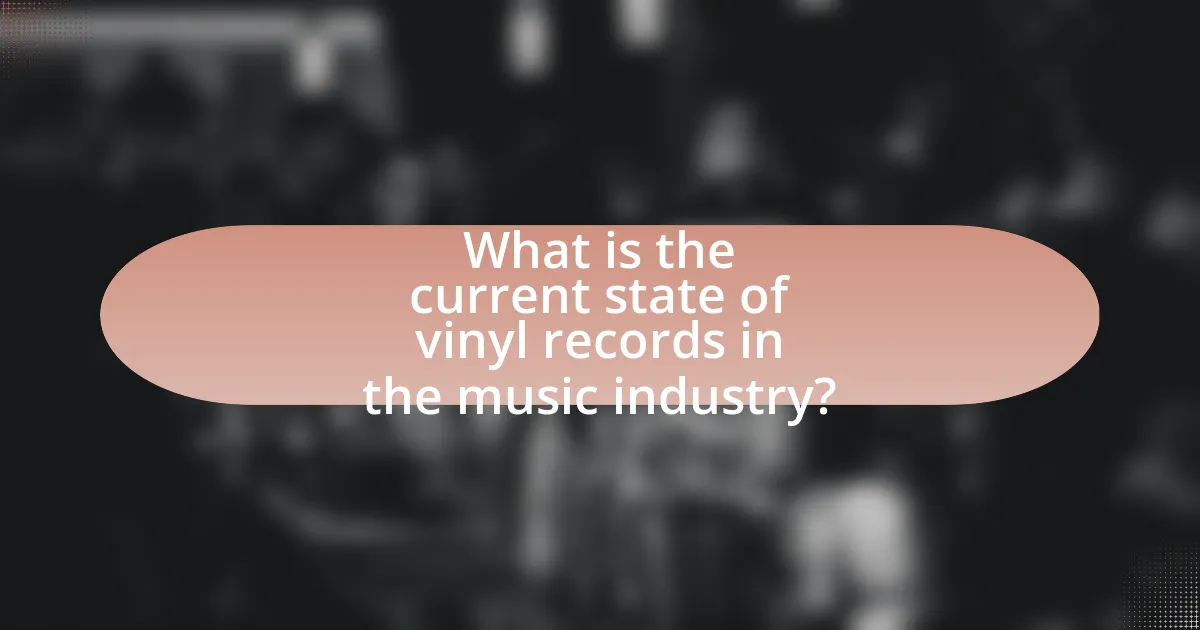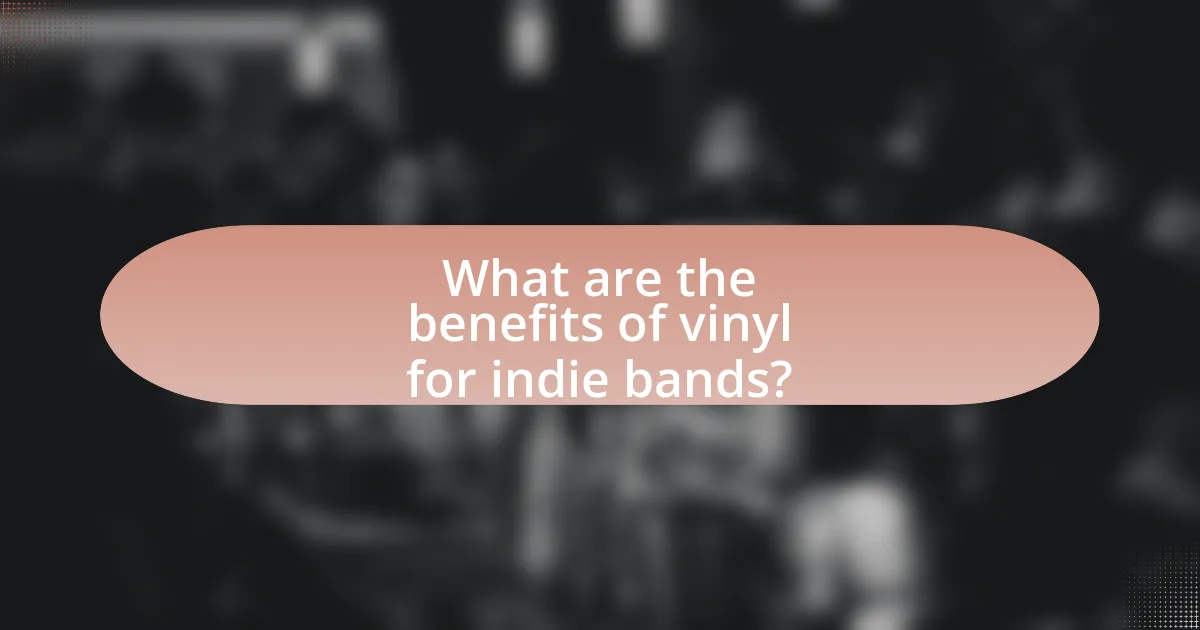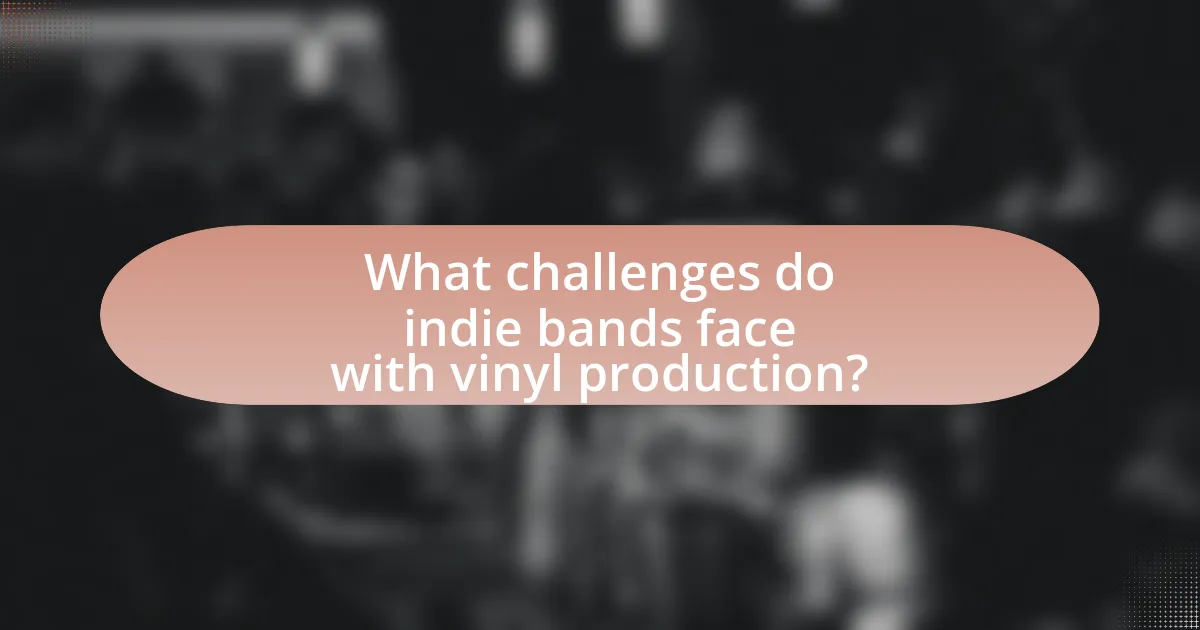The article examines the resurgence of vinyl records in the music industry, particularly among indie bands, highlighting their growing popularity as a physical media format. In 2022, vinyl sales in the U.S. surpassed CD sales for the first time since the 1980s, driven by consumer preferences for tangible music experiences and nostalgia. The article discusses the unique sound quality, tactile engagement, and artistic opportunities that vinyl offers, as well as the challenges indie bands face in production and marketing. It also explores how vinyl enhances brand identity and revenue potential for artists, while providing insights into effective promotional strategies and the historical trends influencing this revival.

What is the current state of vinyl records in the music industry?
The current state of vinyl records in the music industry is one of significant resurgence and popularity. In 2022, vinyl sales in the United States surpassed CD sales for the first time since the 1980s, with vinyl records accounting for 41 million units sold, according to the Recording Industry Association of America (RIAA). This trend reflects a growing consumer preference for physical media, particularly among indie bands, who are increasingly embracing vinyl as a means to connect with fans and enhance their artistic expression. The revival of vinyl is supported by a dedicated collector base and the unique audio experience it offers, further solidifying its place in the modern music landscape.
Why are vinyl records experiencing a resurgence among indie bands?
Vinyl records are experiencing a resurgence among indie bands primarily due to their tangible nature and the unique sound quality they offer. Indie bands are increasingly recognizing that vinyl provides a physical medium that enhances the listening experience, allowing fans to engage more deeply with the music. Additionally, the revival of vinyl aligns with a growing consumer trend towards nostalgia and authenticity in music consumption. According to the Recording Industry Association of America, vinyl sales reached a 30-year high in 2020, indicating a significant market demand that indie bands can capitalize on. This trend not only helps bands differentiate themselves in a digital-dominated landscape but also fosters a stronger connection with their audience through collectible formats.
What factors contribute to the renewed interest in vinyl among musicians?
The renewed interest in vinyl among musicians is primarily driven by the desire for authenticity and a tangible connection to their music. Many artists believe that vinyl offers a richer sound quality compared to digital formats, enhancing the listening experience. Additionally, the physical nature of vinyl allows musicians to create unique artwork and packaging that reflects their artistic vision, fostering a deeper emotional connection with fans. According to the Recording Industry Association of America, vinyl sales have seen a significant increase, with revenue surpassing that of CD sales in recent years, indicating a growing consumer demand for this format. This trend is further supported by the resurgence of vinyl pressing plants, which have expanded to meet the rising production needs of independent artists.
How does the tactile experience of vinyl influence listener engagement?
The tactile experience of vinyl significantly enhances listener engagement by creating a multi-sensory interaction that digital formats cannot replicate. Handling a vinyl record involves physical actions such as removing it from its sleeve, placing it on a turntable, and adjusting the needle, which fosters a deeper connection to the music. Research indicates that this physical engagement can lead to increased emotional investment; for instance, a study published in the Journal of Consumer Research found that tactile interactions can enhance the perceived value of an item, making listeners more likely to appreciate and connect with the music on a personal level. This engagement is further amplified by the larger album artwork and the ritualistic nature of playing vinyl, which encourages listeners to be more present and attentive to the music.
What role does nostalgia play in the popularity of vinyl records?
Nostalgia significantly contributes to the popularity of vinyl records by evoking emotional connections to past experiences and cultural moments. This emotional resonance is particularly strong among consumers who associate vinyl with the music of their youth, creating a sense of longing for simpler times. Research indicates that nostalgia can enhance consumer behavior, as seen in a study published in the Journal of Consumer Research, which found that nostalgic feelings can increase the desire for products that remind individuals of their past, such as vinyl records. Additionally, the tactile experience of handling vinyl and the larger album artwork further amplify this nostalgic appeal, making vinyl not just a medium for music but a tangible connection to memories and cultural heritage.
How does nostalgia affect consumer behavior in music purchasing?
Nostalgia significantly influences consumer behavior in music purchasing by driving individuals to seek out music that evokes fond memories. This emotional connection often leads consumers to prefer physical formats, such as vinyl records, which are associated with past experiences and cultural moments. Research indicates that nostalgia can enhance the perceived value of products; for instance, a study published in the Journal of Consumer Research found that nostalgic feelings can increase consumers’ willingness to pay for items that remind them of their past, particularly in the context of music. This trend is evident as indie bands leverage nostalgia to attract audiences, encouraging purchases of vinyl records that resonate with listeners’ memories and emotions.
What historical trends have influenced the current vinyl revival?
The current vinyl revival has been influenced by several historical trends, including the decline of physical media in the digital age and a resurgence of interest in analog formats. The transition to digital music in the early 2000s led to a significant drop in CD sales, with a 50% decline from 1999 to 2014, prompting consumers to seek more tangible music experiences. Additionally, the rise of nostalgia for past decades, particularly the 1970s and 1980s, has driven interest in vinyl records, as they are often associated with a richer sound quality and a more immersive listening experience. The growth of independent record stores and vinyl pressing plants has also facilitated this revival, with vinyl sales reaching 41 million units in 2020, the highest level since 1986, according to the Recording Industry Association of America.
How does the production process of vinyl differ from digital formats?
The production process of vinyl differs from digital formats primarily in its analog nature, which involves cutting a physical groove into a disc, whereas digital formats rely on binary data stored electronically. In vinyl production, sound waves are converted into mechanical vibrations that create grooves on a master disc during the cutting process, which is then used to press multiple copies. In contrast, digital formats involve recording sound as a series of numerical values that can be easily manipulated and reproduced without physical media. This fundamental difference results in vinyl often capturing a warmer, more organic sound due to its analog characteristics, while digital formats provide convenience and precision in reproduction.
What are the key steps involved in creating a vinyl record?
The key steps involved in creating a vinyl record include mastering, cutting, pressing, and packaging. First, mastering involves preparing the audio for vinyl by optimizing sound quality and ensuring it fits the format’s limitations. Next, cutting refers to transferring the mastered audio onto a lacquer disc using a cutting lathe, which engraves the sound grooves. After cutting, the lacquer is used to create metal stampers through a plating process. These stampers are then used in the pressing stage, where vinyl pellets are heated and pressed into discs, forming the final record. Finally, the records are packaged, often including artwork and labels, ready for distribution. Each step is crucial to ensure the quality and fidelity of the final product.
How do these production differences impact sound quality?
Production differences significantly impact sound quality by influencing the fidelity and warmth of the audio. For instance, analog production techniques, commonly used in vinyl records, capture a broader frequency range and provide a richer sound compared to digital formats, which can introduce quantization errors and compression artifacts. Studies have shown that vinyl records often deliver a more immersive listening experience due to their continuous waveform, as opposed to the discrete samples of digital recordings. This results in a more natural sound that many listeners perceive as superior, particularly in genres that emphasize acoustic instruments and vocal nuances.

What are the benefits of vinyl for indie bands?
Vinyl offers several benefits for indie bands, including enhanced sound quality, tangible product appeal, and increased revenue potential. The analog nature of vinyl records provides a warmer, richer sound compared to digital formats, which can attract audiophiles and dedicated fans. Additionally, vinyl records serve as a physical representation of an artist’s work, allowing bands to create unique artwork and packaging that can enhance their brand identity. This physical product can also command higher prices than digital downloads, contributing to increased revenue. According to the Recording Industry Association of America, vinyl sales have seen significant growth, with revenue reaching over $1 billion in 2022, indicating a strong market for physical media that indie bands can capitalize on.
How does releasing music on vinyl enhance an indie band’s brand?
Releasing music on vinyl enhances an indie band’s brand by creating a tangible, collectible product that resonates with fans and fosters a deeper emotional connection. Vinyl records are often perceived as high-quality, authentic representations of music, which can elevate the band’s image and differentiate them in a crowded digital marketplace. According to a 2021 report by the Recording Industry Association of America, vinyl sales reached a 30-year high, indicating a growing consumer interest in physical formats. This trend allows indie bands to tap into a niche market that values the artistry and craftsmanship associated with vinyl, thereby strengthening their brand identity and loyalty among fans.
What marketing advantages does vinyl provide for indie artists?
Vinyl provides indie artists with unique marketing advantages, including enhanced brand identity and increased consumer engagement. The tactile nature of vinyl creates a physical connection between the artist and the listener, fostering a deeper emotional investment in the music. Additionally, vinyl records often feature larger artwork and packaging, which can serve as a powerful visual marketing tool that stands out in a digital landscape.
Statistics show that vinyl sales have been steadily increasing, with the Recording Industry Association of America reporting that vinyl sales reached 41 million units in 2020, the highest level since 1986. This resurgence indicates a growing consumer preference for physical media, which indie artists can leverage to differentiate themselves from mainstream digital releases. Furthermore, limited edition vinyl releases can create a sense of urgency and exclusivity, driving sales and enhancing the artist’s perceived value in the market.
How can vinyl sales contribute to an indie band’s revenue stream?
Vinyl sales can significantly contribute to an indie band’s revenue stream by providing a higher profit margin compared to digital sales. For instance, while digital downloads typically yield around 70% of the sale price to the artist, vinyl records can be sold at a premium price, often ranging from $20 to $40, allowing bands to earn a larger profit per unit sold. Additionally, vinyl appeals to collectors and enthusiasts, creating a niche market that can lead to increased sales during tours and special releases. According to the Recording Industry Association of America (RIAA), vinyl sales reached a record high in 2020, surpassing $600 million, indicating a growing consumer interest that indie bands can capitalize on. This trend demonstrates that vinyl not only enhances an indie band’s brand but also serves as a viable revenue source in an increasingly digital music landscape.
What unique experiences do vinyl records offer to fans?
Vinyl records offer fans a tactile and immersive listening experience that digital formats cannot replicate. The physical act of handling a record, placing it on a turntable, and carefully lowering the needle creates a ritualistic engagement with music. This process enhances the emotional connection to the album, as fans often appreciate the larger artwork and packaging that accompany vinyl releases. Additionally, the analog sound quality of vinyl is often described as warmer and richer, providing a unique auditory experience that many enthusiasts prefer over compressed digital formats. According to a 2020 report by the Recording Industry Association of America, vinyl sales reached a 30-year high, indicating a growing appreciation for the distinct experience vinyl records provide.
How does the physicality of vinyl create a deeper connection with music?
The physicality of vinyl creates a deeper connection with music by engaging listeners through tactile interaction and visual aesthetics. Handling a vinyl record involves a deliberate process of placing it on a turntable, which fosters a more immersive listening experience compared to digital formats. This engagement is supported by research indicating that physical media can enhance emotional responses; for instance, a study published in the Journal of Consumer Research found that tactile experiences can increase emotional attachment to objects. Additionally, the large album artwork and packaging provide a visual and artistic context that enriches the overall experience, allowing listeners to appreciate the artistry behind the music.
What role do album artwork and packaging play in the vinyl experience?
Album artwork and packaging are crucial elements of the vinyl experience, as they enhance the aesthetic appeal and emotional connection to the music. The large format of vinyl allows for intricate and visually striking designs that can convey the artist’s vision and themes, making the physical product a collectible item. Research indicates that 70% of consumers consider album artwork important when purchasing music, highlighting its role in attracting listeners and creating a memorable experience. Additionally, unique packaging, such as gatefold covers or colored vinyl, adds value and can differentiate an album in a competitive market, further solidifying the importance of these elements in the overall vinyl experience.
How are indie bands leveraging vinyl in their promotional strategies?
Indie bands are leveraging vinyl in their promotional strategies by creating limited edition releases that enhance their brand identity and foster a deeper connection with fans. This approach not only capitalizes on the resurgence of vinyl popularity, which saw a 29.2% increase in sales in 2020 according to the Recording Industry Association of America, but also allows bands to offer tangible products that fans can collect. By incorporating unique artwork, colored vinyl, and exclusive content, indie bands differentiate themselves in a crowded market, driving both sales and engagement.
What innovative approaches are indie bands using to market their vinyl releases?
Indie bands are utilizing innovative approaches such as direct-to-consumer sales through social media platforms and exclusive pre-order campaigns to market their vinyl releases. These strategies allow bands to engage directly with their fanbase, fostering a sense of community and exclusivity. For instance, bands often leverage platforms like Instagram and Bandcamp to showcase limited edition vinyl, creating urgency and excitement among fans. Additionally, some indie bands collaborate with local artists for unique cover art or host listening parties, enhancing the overall experience and connection to the physical product. This trend is supported by the resurgence of vinyl sales, which reached 41 million units in 2022, indicating a growing consumer interest in physical media.
How can social media enhance the visibility of vinyl releases for indie bands?
Social media enhances the visibility of vinyl releases for indie bands by providing a platform for direct engagement with fans and targeted marketing. Through platforms like Instagram, Facebook, and Twitter, indie bands can share visually appealing content, such as album artwork and behind-the-scenes footage, which captures audience interest and encourages sharing. According to a 2021 report by the Recording Industry Association of America, vinyl sales increased by 29.2% from the previous year, indicating a growing consumer interest that can be amplified through social media promotion. Additionally, social media allows for the use of hashtags and collaborations with influencers, expanding reach and attracting new listeners who may be interested in purchasing vinyl records.

What challenges do indie bands face with vinyl production?
Indie bands face significant challenges with vinyl production, primarily due to high costs, long lead times, and limited access to pressing facilities. The production of vinyl records is often expensive, with costs ranging from $1,000 to $5,000 for a small run, which can be prohibitive for indie artists with limited budgets. Additionally, the lead times for pressing can extend from several weeks to several months, creating logistical issues for bands aiming to release music in a timely manner. Furthermore, many pressing plants prioritize larger labels, making it difficult for indie bands to secure production slots. These factors collectively hinder the ability of indie bands to produce and distribute vinyl effectively.
What are the cost implications of producing vinyl records?
Producing vinyl records incurs significant costs primarily due to materials, manufacturing, and distribution. The raw materials, including PVC for the records and paper for packaging, contribute to the overall expense, with PVC prices fluctuating based on market conditions. Manufacturing costs involve the processes of mastering, pressing, and quality control, which can range from $1,000 to $3,000 for a standard run of 500 records. Additionally, distribution costs, including shipping and retailer margins, further impact the final price. According to a 2021 report by the Recording Industry Association of America, the average retail price of a vinyl record has increased, reflecting these rising production costs, which can lead to a retail price of $20 to $40 per record.
How do production timelines for vinyl compare to digital releases?
Production timelines for vinyl are significantly longer than those for digital releases. While digital music can be released almost instantly after production, vinyl records typically require several weeks to months for manufacturing due to processes like mastering, pressing, and quality control. For instance, vinyl pressing plants often have backlogs that can extend timelines, with average production times ranging from 6 to 12 weeks, depending on demand and plant capacity. In contrast, digital releases can be made available within hours, allowing artists to respond quickly to market trends or fan requests. This stark difference in timelines influences how indie bands approach their release strategies, often favoring digital formats for immediate engagement while reserving vinyl for special editions or merchandise.
What logistical issues can arise during vinyl manufacturing?
Logistical issues that can arise during vinyl manufacturing include supply chain disruptions, equipment malfunctions, and quality control challenges. Supply chain disruptions can occur due to shortages of raw materials, such as PVC, which is essential for vinyl production. Equipment malfunctions can lead to delays in the pressing process, as specialized machinery is required to create vinyl records. Additionally, quality control challenges may arise when ensuring that the final product meets industry standards, which can result in increased waste and rework. These factors can significantly impact production timelines and costs, making efficient logistics crucial for successful vinyl manufacturing.
How can indie bands overcome the challenges of vinyl production?
Indie bands can overcome the challenges of vinyl production by leveraging digital tools for design and distribution, collaborating with established pressing plants, and utilizing crowdfunding platforms for financing. Digital tools allow bands to create high-quality artwork and manage logistics efficiently, reducing costs and time. Collaborating with established pressing plants can provide access to better resources and expertise, ensuring higher quality production. Additionally, crowdfunding platforms like Kickstarter enable bands to raise funds upfront, mitigating financial risks associated with vinyl production. These strategies have been successfully employed by various indie bands, demonstrating their effectiveness in navigating the complexities of vinyl manufacturing.
What resources are available to assist indie bands in vinyl production?
Indie bands can access several resources to assist in vinyl production, including specialized pressing plants, funding platforms, and educational materials. Notable pressing plants like Gotta Groove Records and Third Man Pressing offer services tailored for independent artists, providing quality vinyl production with minimum order quantities. Additionally, crowdfunding platforms such as Kickstarter and Indiegogo enable bands to raise funds specifically for vinyl projects, allowing them to gauge interest and secure financial backing. Educational resources, including guides and workshops from organizations like the Independent Music Publishers International Forum, provide valuable insights into the vinyl production process, helping bands navigate the technical and logistical aspects effectively.
How can collaboration with vinyl pressing plants benefit indie artists?
Collaboration with vinyl pressing plants benefits indie artists by providing them with high-quality physical media that enhances their brand and reach. This partnership allows indie artists to produce limited edition vinyl records, which can attract collectors and dedicated fans, thereby increasing sales and visibility. Additionally, vinyl records have seen a resurgence in popularity, with sales reaching 41 million units in the U.S. in 2022, according to the Recording Industry Association of America. This trend indicates a growing market for physical music formats, making collaboration with pressing plants a strategic move for indie artists looking to capitalize on this demand.
What practical tips can indie bands follow when releasing vinyl?
Indie bands should focus on high-quality production, effective marketing strategies, and strategic distribution when releasing vinyl. High-quality production ensures that the sound quality meets industry standards, which is crucial for vinyl records, as poor audio can deter listeners. Effective marketing strategies, such as leveraging social media and engaging with fans through pre-orders and exclusive content, can create buzz and anticipation around the release. Strategic distribution involves selecting the right platforms, such as independent record stores and online retailers, to reach the target audience effectively. According to a report by the Recording Industry Association of America, vinyl sales have seen a resurgence, indicating a growing market that indie bands can tap into by following these practical tips.
How should indie bands approach pricing their vinyl records?
Indie bands should approach pricing their vinyl records by considering production costs, market demand, and perceived value. Production costs typically include manufacturing, artwork, and shipping, which can range from $1,000 to $3,000 for a small run, depending on the quality and quantity. Market demand can be assessed by analyzing similar indie releases, which often price vinyl between $15 and $30. Additionally, perceived value can be enhanced through limited editions or unique packaging, allowing bands to justify higher prices. This pricing strategy aligns with industry trends, as a 2022 report from the Recording Industry Association of America indicated that vinyl sales reached a record high, reflecting a growing consumer interest in physical media.
What strategies can be employed to effectively promote a vinyl release?
To effectively promote a vinyl release, indie bands can utilize a combination of social media marketing, limited edition pressings, and live events. Social media platforms like Instagram and Facebook allow artists to engage directly with fans, share behind-the-scenes content, and create anticipation through countdowns and teasers. Limited edition pressings, such as colored vinyl or unique artwork, create a sense of urgency and exclusivity, driving collectors and fans to purchase. Additionally, hosting live events or listening parties can foster community engagement and provide a tangible experience around the vinyl release, enhancing its appeal. These strategies are supported by the resurgence of vinyl sales, which reached 41 million units in 2020, indicating a strong market for physical media among music enthusiasts.


